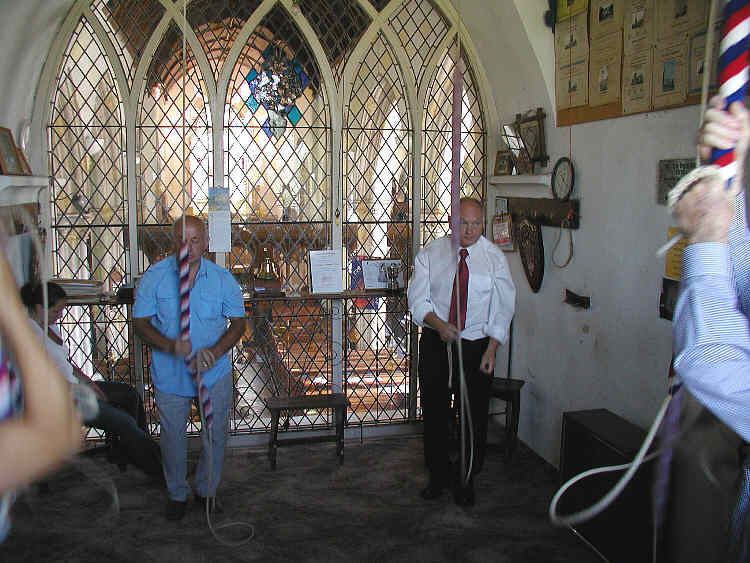 | ||
A bell-ringer is a person who rings a bell, usually a church bell, by means of a rope or other mechanism.
Contents
- Present day activity
- English full circle ringing
- Bolognese bell ringing
- Russia
- Historical Hazards
- References
The term campanologist is popularly mis-used to refer to a bell ringer, but this properly refers to someone who studies bells, which is known as campanology.
Although in some places carillons are used to sound bells, they are "played" by carillonneurs, not by bell ringers, and are associated with the ringing of tunes in the Western musical tradition.
Present-day activity
Despite some automation of bells ringing usually in an uncoordinated fashion, there are still a large number of active bell ringers in the world, ringing in many different styles and traditions to sound bells in an ordered or artistic way.
English full-circle ringing
In England, for instance, it is estimated there are about 40,000 bell ringers ringing on rings of bells in the English full-circle style. This type of ringing cannot be automated because of the large rotating masses of the bells and the exact regulation in speed of striking that is required for change ringing. This style of ringing takes place every week in several thousand belfries in England and is supported by the Central Council of Church Bell Ringers founded in 1891, which is also dedicated to representing change ringers around the world.
Bolognese bell ringing
This system took shape during the Middle Ages, and was perfected in the 19th century. It is a form of full circle ringing. It was originally designed for an ensemble of four or five bells. Nowadays it is also sometimes used for a set of six bells.
The bells are never counterbalanced. They are mounted on a wooden structure called the castle, and flanked by a wooden support called the goat. The bells are not very heavy, as the rotation has to be fast. Generally, every bell that weighs less than 800 kg (16 cwt) is rung by one person. The heaviest bell used with this system is in Bologna Cathedral, and is called la Nonna ("the Granny") and weighs 3.3 tonnes. Thirteen people are needed to ring a scappata or a calata with it. The bell ringers have to be in contact with the bells and mechanical devices are not allowed.
Russia
Bell ringing saw a spectacular revival in Russia, with the growth of the Russian Orthodox Church, (see Russian Orthodox bell ringing).
Technically, bells rung in the Russian tradition are sounded exclusively by chiming (i.e., moving only the clapper so that it strikes the side of a stationary bell) and never by swinging the bell. For the Russian tradition a special complex system of ropes is used, designed individually for each belltower. All the ropes are gathered at approximately one point, where the bell-ringer (zvonar) stands. Some ropes (the smaller ones) are played by hand, the bigger ropes are played by foot. The major part of the ropes (usually - all ropes) are not actually pulled, but rather pressed. Since one end of every rope is fixed, and the ropes are kept in tension, a press or even a punch on a rope makes a clapper strike the side of its bell.
The secrets of this technique have passed from generation to generation, but by the 20th century this art was almost lost. Training took place only at workshops until 2008, then the first permanent traditional bell-ringing school opened in Moscow, under the leadership of Drozdihin Ilya.
Historical Hazards
In the Middle Ages, it was believed that the sound of a bell could disperse thunder. A large number of bell-ringers were electrocuted as a result. In France between the years 1753 and 1786, 103 bell-ringers were killed during thunderstorms as a result of holding on to wet bell ropes. The Parlement of Paris enforced an edict in 1786 to prohibit the practice. Deaths likely continued until the 19th century, when the lightning rod came into general use.
